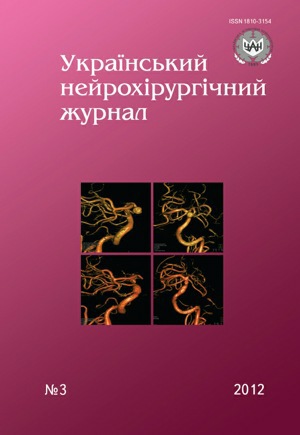Clinical and neurophysiological matching in patients of different age with lumbar spine stenosis
DOI:
https://doi.org/10.25305/unj.60843Keywords:
lumbar spine stenosis, neurogenic intermittent claudication, diagnostics, motor evoked potentials, electroneuromyographyAbstract
Introduction. The urgency of a subject is caused by need to optimize diagnostics in patients of different age with lumbar spine stenosis.
Materials and methods. The results of clinical and neurophysiological (NPh) examination of 79 patients aged from 17 to 80 years with lumbar spine stenosis were analyzed. Depending on age patients were divided into 5 groups. Clinical signs and NPh-markers of roots and spinal structures defeat were studied. NPh examination included: electroneuromyography (ENMG) with F-waves registration, evoked motor potentials (EMP) recording. For identification of clinical and NPh changes we carried out provocative tests and loading test: walking to an symptoms aggravation.
Results. In all patients with lumbar spine stenosis EМP changes were revealed in comparison with those in control group: latency of cortical EMP was increased in 41 (51.9%) patients, time of central motor conduction — in 33 (41.8%). The frequency of NPh spinal defeats in patients from 3–5 groups was authentically higher than in patients from 1st and 2nd groups. Accompanying sensomotor polyneuropathy at lumbar spine stenosis according to ENMG data was revealed in the 3rd group at 14.3% patients, in the 4th group — at 32.2%, in the 5th group — at 80%.
Conclusions. It was established that in patients with lumbar spine stenosis with age frequency of poliradicular and myelopathy symptoms, caudo- and myelogenic intermittent claudication increases.
References
1. Chernyshev A G, Fedotova IF, Feklina IV, Levshin AA. Dinamika nevrologicheskogo statusa u bolnykh s poyasnichnym spinalnym stenozom posle khirurgicheskogo lecheniya [Neurological state dynamics in patients with lumbar spinal stenosis after surgical treatment]. Mezhdunarodnyy meditsinskiy zhurnal. 2011;2:10–14. Russian. http://dspace.nbuv.gov.ua/handle/123456789/30647
2. Prodan AI, Radchenko VA, Korzh NA. Degenerativnyye zabolevaniya pozvonochnika [Degenerative diseases of the spine]. T. 1: Semiotika. Klassifikatsiya. Diagnostika. Kharkov: Kontrastzh; 2007. Russian.
3. Zozulya YuA, Pedachenko Ye G, Slynko Ye I. Khirurgicheskoye lecheniye neyrokompressionnykh poyasnichno-kresttsovykh bolevykh sindromov. Kiev: UIPK «YeksOb»: 2006. Russian.
4. Prodan AI, Perepechay OA, Podlipentsev VV. Kontseptualnaya model peremezhayushcheysya neyrogennoy khromoty i tranzitornoy radikulopatii pri poyasnichnom spinalnom stenoze. Lítopis travmatologíyi ta ortopedíyi. 2008;1(2):218–225. Russian.
5. Omelchenko AV. Stenozy poyasnichnogo otdela pozvonochnogo kanala: tipy klinicheskogo techeniya, rezultaty khirurgicheskogo lecheniya [Stenosis of the lumbar spinal canal: the types of clinical course, surgical treatment results]. [dissertation]: Russian Scientific Research Institute of Neurosurgery. St. Petersburg; 2004. Russian.
6. Polishchuk NE, Isayenko A. Klinika i differentsialnaya diagnostika poyasnichnogo stenoza [Clinic and differential diagnosis of lumbar stenosis]. Ukr. med. chasopis. 2001;2:106–109. Russian.
7. Adamova B, Vohanka S, Dusek L. Dynamic electrophysiological examination in patients with lumbar spinal stenosis: Is it useful in clinical practice?. European Spine Journal. 2004;14(3):269-276. [CrossRef]
8. Liu X, Konno S, Miyamoto M, Gembun Y, Horiguchi G, Ito H. Clinical value of motor evoked potentials with transcranial magnetic stimulation in the assessment of lumbar spinal stenosis. Int Orthop. 2009;33(4):1069-1074. [CrossRef] [PubMed]
9. Kimura J. Electrodiagnosis in diseases of nerve and muscle: principles and practice. Oxford Univ. Press Inc; 2001.
10. Bal S, Celiker R, Palaoglu S, Cila A. F Wave Studies of Neurogenic Intermittent Claudication in Lumbar Spinal Stenosis. American Journal of Physical Medicine & Rehabilitation. 2006;85(2):135-140. [CrossRef] [PubMed]
11. Di Lazzaro V, Pilato F, Oliviero A, Saturno E, Dileone M, Tonali P. Role of motor evoked potentials in diagnosis of cauda equina and lumbosacral cord lesions. Neurology. 2004;63(12):2266-2271. [CrossRef] [PubMed]
12. Lang E, Hilz M, Erxleben H, Ernst M, Neundörfer B, Liebig K. Reversible Prolongation of Motor Conduction Time After Transcranial Magnetic Brain Stimulation After Neurogenic Claudication in Spinal Stenosis. Spine. 2002;27(20):2284-2290. [CrossRef] [PubMed]
13. Prodan AI, Perepechay A, Kolesnichenko VA. Diagnostika poyasnichnogo spinalnogo stenoza [Diagnosis of lumbar spinal stenosis]. Vestn. travmatologii i ortopedii im. N.N. Priorova. 2008;3:77–81. Russian.
14. Arinzon Z, Adunsky A, Fidelman Z, Gepstein R. Outcomes of decompression surgery for lumbar spinal stenosis in elderly diabetic patients. European Spine Journal. 2004;13(1):32-37. [CrossRef] [PubMed]
15. Kachi T, Sobue I. [Ageing and central motor conduction time]. Nihon Ronen Igakkai Zasshi. Japanese. 1990;27(6):724-727. [PubMed]
16. Nikitin SS, Kurenkov AL. Magnitnaya stimulyatsiya v diagnostike i lechenii bolezney nervnoy sistemy: rukovodstvo dlya vrachey [Magnetic stimulation in the diagnosis and treatment of diseases of the nervous system: Guidelines for Physicians]. Moscow: SASHKO; 2003. Russian.
17. Muller K, Homberg V, Lenard H. Magnetic stimulation of motor cortex and nerve roots in children. Maturation of cortico-motoneuronal projections. Electroencephalography and Clinical Neurophysiology/Evoked Potentials Section. 1991;81(1):63-70. [CrossRef]
18. Skoromets AA, Skoromets AP, Skoromets TA, Tissen TP. Spinalnaya angionevrologiya: rukovodstvo dlya vrachey [Spinal Angiology: Guidelines for Physicians]. Moscow:MEDpress-inform; 2003. Russian.
19. Zenkov LR, Ronkin MA. Funktsionalnaya diagnostika nervnykh bolezney: rukovodstvo dlya vrachey [Functional diagnosis of nervous diseases: Guidelines for Physicians]. Moscow: MEDpress-inform; 2004. Russian.
20. Oh S. Clinical electromyography: Nerve conduction studies. Baltimore: Univer. Park Press; 1984. [CrossRef]
Downloads
Published
How to Cite
Issue
Section
License
Copyright (c) 2012 Lidiya Chebotariova, Albina Tretiakova, Yuriy Pedachenko, Elena Krasilenko

This work is licensed under a Creative Commons Attribution 4.0 International License.
Ukrainian Neurosurgical Journal abides by the CREATIVE COMMONS copyright rights and permissions for open access journals.
Authors, who are published in this Journal, agree to the following conditions:
1. The authors reserve the right to authorship of the work and pass the first publication right of this work to the Journal under the terms of Creative Commons Attribution License, which allows others to freely distribute the published research with the obligatory reference to the authors of the original work and the first publication of the work in this Journal.
2. The authors have the right to conclude separate supplement agreements that relate to non-exclusive work distribution in the form of which it has been published by the Journal (for example, to upload the work to the online storage of the Journal or publish it as part of a monograph), provided that the reference to the first publication of the work in this Journal is included.









